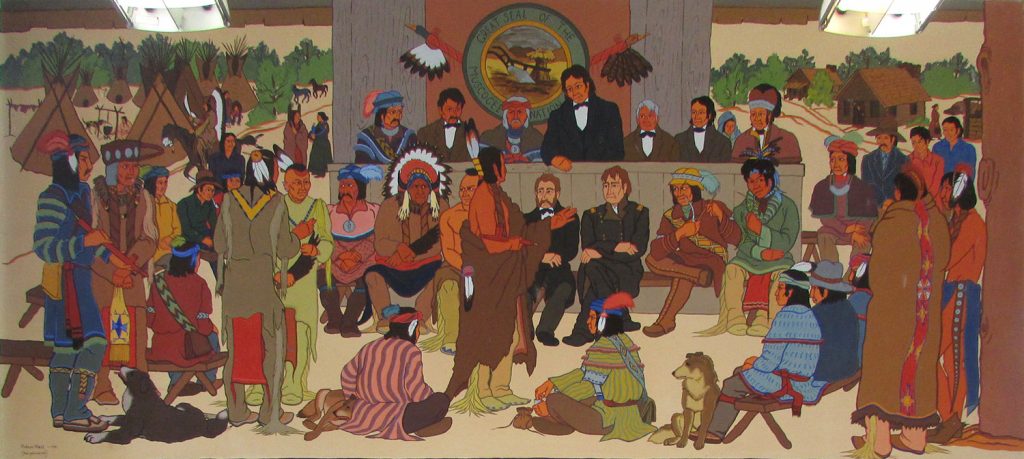| Address: | 418 West Broadway Okemah, OK 74859 | County: | Okfuskee |
| Started: | Completed: | 1941 | |
| Agencies: | Treasury Department | NRHP: | No |
Description:

The post office contains a 1941 Section of Fine Arts mural “Grand Council of 1842” painted by Richard West.
This work is a work having a rather flat perspective by West depicting the Grand Council of 1842, probably 1843 which was a peace treaty between multiple Indian Tribes and Texas. The treaty was signed in March of 1843 and subsequently a Grand Council of representatives of the Delawares, CAddoes, Wacos, Shawnees, Ionies, Anadarko, Tawakano, Wichitas, and Kichai. The treaty was signed and then completed in September at Bird’s Fort.
Richard West was born near the Darlington Agency in Oklahoma, attended the Haskell Institute, Bacone College, University of Oklahoma. The artists he studied with were Carl Sweezy, Acee Blue Eagle, Olle Nordmark, and Oscar Jacobson. He was the chair of the Art Department at Bacone College in Muskogee, OK from 1947-1970.
This is a one-story buff brick building with basement. Architecturally it reflects the Art Deco style, but is a modest example with few decorative details. It possesses a symmetrical facade, and a large iron grille with an eagle design marks the door. A very colorful mural designed a painted by Richard West in 1941 graces the west wall. Titled Grand Council of 1842, the mural remains in good condition though it was accidentally splattered with paint about 1991, when the interior of the building was repainted. This post office deserves listing in the National Register not only because of its association with New Deal art and the Oklahoma Indian artist Dick West, but also because of its depiction of Indian history in the Okemah vicinity.
Cheyenne (1912-96). Grand Council of 1842.
by Walter Richard West. (Wah-Pah-NahYah. Wapah Nahyah. Light Foot Runner). 1941, egg tempera on canvas.
Grand Council of 1842 depicts a significant treaty between the displaced Southeastern tribes, Cherokee, Chickasaw, Choctaw, Creek, and Seminole, and the Plains tribes of the area, such as the Cheyenne and Kiowa. The dispute between the two groups began over the dwindling bison herds in the area, as West noted: ‘”When the territory tribes did not stop hide hunting, the Plains tribes started raiding the settlements and towns in the eastern part of the territory from the northern to the southern parts, burning cabins and driving stock.”3 According to West’s research, the Creek’s took the initiative in settling the dispute by calling a council of the tribes at the Deep Fork River near Okemah. American officials, headed by General Zachary Taylor of Ft. Gibson and Creek Indian agent James Logan, helped to arbitrate the dispute successfully; however, the American military began construction of the nearby Ft. Washita that same year as a buffer between the competing tribes.
West included Taylor and Logan in the center of the composition among the large number of delegates from both Southeastern and Plains tribes. The primary officials from both groups have collected at the treaty table under both the seal of the Muscogee or Creek and a pair of peace pipes, indicating the formal and peaceful nature of the council. Other delegates from varying tribes listen attentively to the proceedings. The artist depicted numerous tip is at left and a collection of log cabins at right, indicating the presence and settlements of the Plains tribes and the Southeastern tribes, respectively.
Stylistically, Grand Council of 1842 displays the careful attention to detail and specificity that characterizes Traditional Indian Painting and especially West’s work. The artist often aspired to historical accuracy in the depiction of dress and architecture, and the careful drawing and coloring of the mural’s forms indicates the desire to recreate every detail of the historical event. In fact, accuracy led West to study historical materials at the Smithsonian Institution, including a surviving painting of the council probably by the artist James Otto Lewis. West’s naturalism in Grand Council of 1842 would have been contrasted originally by a series of abstract Cheyenne designs derived largely from beadwork; the designs bordered the door and bulletin boards below the mural but were either removed or painted over during the history of the mural. This alteration may have undermined West’s intent, but Grand Council of 1842 remains a successful interpretation of local history.[5]
Sources:
- The Living New Deal
- Park and Markowitz, Democratic Vistas, Post Offices and Public Art in the New Deal, 1984.
- http://www.newdealartregistry.org/
- Indians of the Post Office
- Thematic Survey of New Deal Era Public Art in Oklahoma 2003-2004, Project Number: 03-401 (Department of Geography, Oklahoma State University)



Leave a Reply